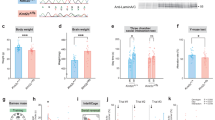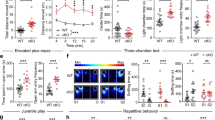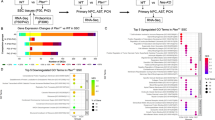Abstract
Exome sequencing has enabled the identification of causative genes of monogenic forms of autism, amongst them, in 2016, CSNK2A1, the gene encoding the catalytic subunit of the kinase CK2, linking this kinase to Okur-Chung Neurodevelopmental Syndrome (OCNDS), a newly described neurodevelopmental condition with many symptoms resembling those of autism spectrum disorder. Thus far, no preclinical model of this condition exists. Here we describe a knock-in mouse model that harbors the K198R mutation in the activation segment of the α subunit of CK2. This region is a mutational hotspot, representing one-third of patients. These mice exhibit behavioral phenotypes that mirror patient symptoms. Homozygous knock-in mice die mid-gestation while heterozygous knock-in mice are born at half of the expected mendelian ratio and are smaller in weight and size than wildtype littermates. Heterozygous knock-in mice showed alterations in cognition and memory-assessing paradigms, enhanced stereotypies, altered circadian activity patterns, and nesting behavior. Phosphoproteome analysis from brain tissue revealed alterations in the phosphorylation status of major pre- and postsynaptic proteins of heterozygous knock-in mice. In congruence, we detect reduced synaptic maturation in hippocampal neurons and attenuated long-term potentiation in the hippocampus of knock-in mice. Taken together, heterozygous knock-in mice (CK2αK198R/+) exhibit significant face validity, presenting ASD-relevant phenotypes, synaptic deficits, and alterations in synaptic plasticity, all of which strongly validate this line as a mouse model of OCNDS.
This is a preview of subscription content, access via your institution
Access options
Subscribe to this journal
Receive 12 print issues and online access
269,00 € per year
only 22,42 € per issue
Buy this article
- Purchase on SpringerLink
- Instant access to full article PDF
Prices may be subject to local taxes which are calculated during checkout






Similar content being viewed by others
References
Frances L, Quintero J, Fernandez A, Ruiz A, Caules J, Fillon G, et al. Current state of knowledge on the prevalence of neurodevelopmental disorders in childhood according to the DSM-5: a systematic review in accordance with the PRISMA criteria. Child Adolesc Psychiatry Ment Health. 2022;16:27.
Parenti I, Rabaneda LG, Schoen H, Novarino G. Neurodevelopmental disorders: from genetics to functional pathways. Trends Neurosci. 2020;43:608–21.
Baron-Cohen S, Belmonte MK. Autism: a window onto the development of the social and the analytic brain. Annu Rev Neurosci. 2005;28:109–26.
Okur V, Cho MT, Henderson L, Retterer K, Schneider M, Sattler S, et al. De novo mutations in CSNK2A1 are associated with neurodevelopmental abnormalities and dysmorphic features. Hum Genet. 2016;135:699–705.
Trinh J, Huning I, Budler N, Hingst V, Lohmann K, Gillessen-Kaesbach G. A novel de novo mutation in CSNK2A1: reinforcing the link to neurodevelopmental abnormalities and dysmorphic features. J Hum Genet. 2017;62:1005–6.
Chiu ATG, Pei SLC, Mak CCY, Leung GKC, Yu MHC, Lee SL, et al. Okur-Chung neurodevelopmental syndrome: Eight additional cases with implications on phenotype and genotype expansion. Clin Genet. 2018;93:880–90.
Owen CI, Bowden R, Parker MJ, Patterson J, Patterson J, Price S, et al. Extending the phenotype associated with the CSNK2A1-related Okur-Chung syndrome-A clinical study of 11 individuals. Am J Med Genet A. 2018;176:1108–14.
Colavito D, Del Giudice E, Ceccato C, Dalle Carbonare M, Leon A, Suppiej A. Are CSNK2A1 gene mutations associated with retinal dystrophy? Report of a patient carrier of a novel de novo splice site mutation. J Hum Genet. 2018;63:779–81.
Akahira-Azuma M, Tsurusaki Y, Enomoto Y, Mitsui J, Kurosawa K. Refining the clinical phenotype of Okur-Chung neurodevelopmental syndrome. Hum Genome Var. 2018;5:18011.
Martinez-Monseny AF, Casas-Alba D, Arjona C, Bolasell M, Casano P, Muchart J, et al. Okur-Chung neurodevelopmental syndrome in a patient from Spain. Am J Med Genet A. 2020;182:20–4.
Wu RH, Tang WT, Qiu KY, Li XJ, Tang DX, Meng Z, et al. Identification of novel CSNK2A1 variants and the genotype-phenotype relationship in patients with Okur-Chung neurodevelopmental syndrome: a case report and systematic literature review. J Int Med Res. 2021;49:3000605211017063.
Ceglia I, Flajolet M, Rebholz H. Predominance of CK2alpha over CK2alpha’ in the mammalian brain. Mol Cell Biochem. 2011;356:169–75.
Niefind K, Guerra B, Ermakowa I, Issinger OG. Crystal structure of human protein kinase CK2: insights into basic properties of the CK2 holoenzyme. EMBO J. 2001;20:5320–31.
Ruzzene M, Pinna LA. Addiction to protein kinase CK2: a common denominator of diverse cancer cells? Biochim Biophys Acta. 2010;1804:499–504.
D’Amore C, Borgo C, Sarno S, Salvi M. Role of CK2 inhibitor CX-4945 in anti-cancer combination therapy - potential clinical relevance. Cell Oncol. 2020;43:1003–16.
Girault JA, Hemmings HC Jr, Zorn SH, Gustafson EL, Greengard P. Characterization in mammalian brain of a DARPP-32 serine kinase identical to casein kinase II. J Neurochem. 1990;55:1772–83.
Lou DY, Dominguez I, Toselli P, Landesman-Bollag E, O’Brien C, Seldin DC. The alpha catalytic subunit of protein kinase CK2 is required for mouse embryonic development. Mol Cell Biol. 2008;28:131–9.
Rebholz H, Nishi A, Liebscher S, Nairn AC, Flajolet M, Greengard P. CK2 negatively regulates Galphas signaling. Proc Natl Acad Sci USA. 2009;106:14096–101.
Castello J, LeFrancois B, Flajolet M, Greengard P, Friedman E, Rebholz H. CK2 regulates 5-HT4 receptor signaling and modulates depressive-like behavior. Mol Psychiatry. 2017;23:872–82.
Rebholz H, Zhou M, Nairn AC, Greengard P, Flajolet M. Selective knockout of the casein kinase 2 in d1 medium spiny neurons controls dopaminergic function. Biol Psychiatry. 2013;74:113–21.
Dominguez I, Cruz-Gamero JM, Corasolla V, Dacher N, Rangasamy S, Urbani A, et al. Okur-Chung neurodevelopmental syndrome-linked CK2alpha variants have reduced kinase activity. Hum Genet. 2021;140:1077–96.
Werner C, Gast A, Lindenblatt D, Nickelsen A, Niefind K, Jose J, et al. Structural and enzymological evidence for an altered substrate specificity in Okur-Chung Neurodevelopmental Syndrome Mutant CK2alpha(Lys198Arg). Front Mol Biosci. 2022;9:831693.
Caefer DM, Phan NQ, Liddle JC, Balsbaugh JL, O’Shea JP, Tzingounis AV, et al. The Okur-Chung Neurodevelopmental Syndrome Mutation CK2(K198R) Leads to a Rewiring of Kinase Specificity. Front Mol Biosci. 2022;9:850661.
Ballardin D, Cruz-Gamero JM, Bienvenu T, Rebholz H. Comparing two neurodevelopmental disorders linked to CK2: Okur-Chung neurodevelopmental syndrome and Poirier-Bienvenu neurodevelopmental syndrome-two sides of the same coin? Front Mol Biosci. 2022;9:850559.
Dodero L, Damiano M, Galbusera A, Bifone A, Tsaftsaris SA, Scattoni ML, et al. Neuroimaging evidence of major morpho-anatomical and functional abnormalities in the BTBR T+TF/J mouse model of autism. PLoS ONE. 2013;8:e76655.
Wolff JJ, Gerig G, Lewis JD, Soda T, Styner MA, Vachet C, et al. Altered corpus callosum morphology associated with autism over the first 2 years of life. Brain. 2015;138:2046–58.
Di Maira G, Salvi M, Arrigoni G, Marin O, Sarno S, Brustolon F, et al. Protein kinase CK2 phosphorylates and upregulates Akt/PKB. Cell Death Differ. 2005;12:668–77.
Gazestani VH, Pramparo T, Nalabolu S, Kellman BP, Murray S, Lopez L, et al. A perturbed gene network containing PI3K-AKT, RAS-ERK and WNT-beta-catenin pathways in leukocytes is linked to ASD genetics and symptom severity. Nat Neurosci. 2019;22:1624–34.
Bibby AC, Litchfield DW. The multiple personalities of the regulatory subunit of protein kinase CK2: CK2 dependent and CK2 independent roles reveal a secret identity for CK2beta. Int J Biol Sci. 2005;1:67–79.
Fenster SD, Chung WJ, Zhai R, Cases-Langhoff C, Voss B, Garner AM, et al. Piccolo, a presynaptic zinc finger protein structurally related to bassoon. Neuron. 2000;25:203–14.
Meggio F, Marin O, Pinna LA. Substrate specificity of protein kinase CK2. Cell Mol Biol Res. 1994;40:401–9.
Schumann CM, Hamstra J, Goodlin-Jones BL, Lotspeich LJ, Kwon H, Buonocore MH, et al. The amygdala is enlarged in children but not adolescents with autism; the hippocampus is enlarged at all ages. J Neurosci. 2004;24:6392–401.
Banker SM, Gu X, Schiller D, Foss-Feig JH. Hippocampal contributions to social and cognitive deficits in autism spectrum disorder. Trends Neurosci. 2021;44:793–807.
Kouser M, Speed HE, Dewey CM, Reimers JM, Widman AJ, Gupta N, et al. Loss of predominant Shank3 isoforms results in hippocampus-dependent impairments in behavior and synaptic transmission. J Neurosci. 2013;33:18448–68.
Ravizza SM, Solomon M, Ivry RB, Carter CS. Restricted and repetitive behaviors in autism spectrum disorders: the relationship of attention and motor deficits. Dev Psychopathol. 2013;25:773–84.
Courchet V, Roberts AJ, Meyer-Dilhet G, Del Carmine P, Lewis TL Jr, Polleux F, et al. Haploinsufficiency of autism spectrum disorder candidate gene NUAK1 impairs cortical development and behavior in mice. Nat Commun. 2018;9:4289.
Turner AH, Greenspan KS, van Erp TGM. Pallidum and lateral ventricle volume enlargement in autism spectrum disorder. Psychiatry Res Neuroimaging. 2016;252:40–5.
Movsas TZ, Pinto-Martin JA, Whitaker AH, Feldman JF, Lorenz JM, Korzeniewski SJ, et al. Autism spectrum disorder is associated with ventricular enlargement in a low birth weight population. J Pediatr. 2013;163:73–8.
Egaas B, Courchesne E, Saitoh O. Reduced size of corpus callosum in autism. Arch Neurol. 1995;52:794–801.
Chiu ATG, Pei SLC, Mak CCY, Leung GKC, Yu MHC, Lee SL, et al. Okur‐Chung neurodevelopmental syndrome: Eight additional cases with implications on phenotype and genotype expansion. Clin Genet. 2018;93:880–90.
Wu R, Tang W, Qiu K, Li X, Tang D, Meng Z, et al. Identification of novel CSNK2A1 variants and the genotype–phenotype relationship in patients with Okur–Chung neurodevelopmental syndrome: a case report and systematic literature review. J Int Med Res. 2021;49:030006052110170.
Girault JA, Hemmings HC Jr, Williams KR, Nairn AC, Greengard P. Phosphorylation of DARPP-32, a dopamine- and cAMP-regulated phosphoprotein, by casein kinase II. J Biol Chem. 1989;264:21748–59.
Stipanovich A, Valjent E, Matamales M, Nishi A, Ahn JH, Maroteaux M, et al. A phosphatase cascade by which rewarding stimuli control nucleosomal response. Nature. 2008;453:879–84.
Huber KM, Klann E, Costa-Mattioli M, Zukin RS. Dysregulation of mammalian target of Rapamycin signaling in mouse models of autism. J Neurosci. 2015;35:13836–42.
Chen J, Alberts I, Li X. Dysregulation of the IGF-I/PI3K/AKT/mTOR signaling pathway in autism spectrum disorders. Int J Dev Neurosci. 2014;35:35–41.
Yeung KS, Tso WWY, Ip JJK, Mak CCY, Leung GKC, Tsang MHY, et al. Identification of mutations in the PI3K-AKT-mTOR signalling pathway in patients with macrocephaly and developmental delay and/or autism. Mol Autism. 2017;8:66.
Mencer S, Kartawy M, Lendenfeld F, Soluh H, Tripathi MK, Khaliulin I, et al. Proteomics of autism and Alzheimer’s mouse models reveal common alterations in mTOR signaling pathway. Transl Psychiatry. 2021;11:480.
Ding X, Bloch W, Iden S, Ruegg MA, Hall MN, Leptin M, et al. mTORC1 and mTORC2 regulate skin morphogenesis and epidermal barrier formation. Nat Commun. 2016;7:13226.
Meikle L, Pollizzi K, Egnor A, Kramvis I, Lane H, Sahin M, et al. Response of a neuronal model of tuberous sclerosis to mammalian target of rapamycin (mTOR) inhibitors: effects on mTORC1 and Akt signaling lead to improved survival and function. J Neurosci. 2008;28:5422–32.
Franchin C, Borgo C, Cesaro L, Zaramella S, Vilardell J, Salvi M, et al. Re-evaluation of protein kinase CK2 pleiotropy: new insights provided by a phosphoproteomics analysis of CK2 knockout cells. Cell Mol Life Sci. 2018;75:2011–26.
Huguet GEE, Bourgeron T. The genetic landscapes of autism spectrum disorders. T. Annu Rev Genomics Hum Genet. 2013;14:191–213.
Chung HJ, Huang YH, Lau LF, Huganir RL. Regulation of the NMDA receptor complex and trafficking by activity-dependent phosphorylation of the NR2B subunit PDZ ligand. J Neurosci. 2004;24:10248–59.
Bulat V, Rast M, Pielage J. Presynaptic CK2 promotes synapse organization and stability by targeting Ankyrin2. J Cell Biol. 2014;204:77–94.
Kimura R, Matsuki N. Protein kinase CK2 modulates synaptic plasticity by modification of synaptic NMDA receptors in the hippocampus. J Physiol. 2008;586:3195–206.
Kraeuter AK, Guest PC, Sarnyai Z. The Y-Maze for assessment of spatial working and reference memory in mice. Methods Mol Biol. 2019;1916:105–11.
Zhang CL, Aime M, Laheranne E, Houbaert X, El Oussini H, Martin C, et al. Protein Kinase A deregulation in the medial prefrontal cortex impairs working memory in Murine Oligophrenin-1 deficiency. J Neurosci. 2017;37:11114–26.
Porcu M, Cocco L, Marrosu F, Cau R, Suri JS, Qi Y, et al. Impact of corpus callosum integrity on functional interhemispheric connectivity and cognition in healthy subjects. Brain Imaging Behav. 2024;18:141–58.
Frederiksen KS. Corpus callosum in aging and dementia. Dan Med J. 2013;60:B4721.
Negron-Oyarzo I, Neira D, Espinosa N, Fuentealba P, Aboitiz F. Prenatal stress produces persistence of remote memory and disrupts functional connectivity in the Hippocampal-Prefrontal Cortex Axis. Cereb Cortex. 2015;25:3132–43.
Rodriguez GA, Burns MP, Weeber EJ, Rebeck GW. Young APOE4 targeted replacement mice exhibit poor spatial learning and memory, with reduced dendritic spine density in the medial entorhinal cortex. Learn Mem. 2013;20:256–66.
Gawel K, Gibula E, Marszalek-Grabska M, Filarowska J, Kotlinska JH. Assessment of spatial learning and memory in the Barnes maze task in rodents-methodological consideration. Naunyn Schmiedebergs Arch Pharmacol. 2019;392:1–18.
Kim JJ, Diamond DM. The stressed hippocampus, synaptic plasticity and lost memories. Nat Rev Neurosci. 2002;3:453–62.
Rohleder C, Wiedermann D, Neumaier B, Drzezga A, Timmermann L, Graf R, et al. The functional networks of prepulse inhibition: neuronal connectivity analysis based on FDG-PET in awake and unrestrained rats. Front Behav Neurosci. 2016;10:148.
Kedia S, Chattarji S. Marble burying as a test of the delayed anxiogenic effects of acute immobilisation stress in mice. J Neurosci Methods. 2014;233:150–4.
Moy SS, Riddick NV, Nikolova VD, Teng BL, Agster KL, Nonneman RJ, et al. Repetitive behavior profile and supersensitivity to amphetamine in the C58/J mouse model of autism. Behav Brain Res. 2014;259:200–14.
Sungur AO, Vorckel KJ, Schwarting RK, Wohr M. Repetitive behaviors in the Shank1 knockout mouse model for autism spectrum disorder: developmental aspects and effects of social context. J Neurosci Methods. 2014;234:92–100.
Sonzogni M, Wallaard I, Santos SS, Kingma J, du Mee D, van Woerden GM, et al. A behavioral test battery for mouse models of Angelman syndrome: a powerful tool for testing drugs and novel Ube3a mutants. Mol Autism. 2018;9:47.
Amodeo DA, Jones JH, Sweeney JA, Ragozzino ME. Differences in BTBR T+ tf/J and C57BL/6J mice on probabilistic reversal learning and stereotyped behaviors. Behav Brain Res. 2012;227:64–72.
Shmelkov SV, Hormigo A, Jing D, Proenca CC, Bath KG, Milde T, et al. Slitrk5 deficiency impairs corticostriatal circuitry and leads to obsessive-compulsive-like behaviors in mice. Nat Med. 2010;16:598–602.
Spencer CM, Alekseyenko O, Hamilton SM, Thomas AM, Serysheva E, Yuva-Paylor LA, et al. Modifying behavioral phenotypes in Fmr1KO mice: genetic background differences reveal autistic-like responses. Autism Res. 2011;4:40–56.
Balaan C, Corley MJ, Eulalio T, Leite-Ahyo K, Pang APS, Fang R, et al. Juvenile Shank3b deficient mice present with behavioral phenotype relevant to autism spectrum disorder. Behav Brain Res. 2019;356:137–47.
Blundell J, Blaiss CA, Etherton MR, Espinosa F, Tabuchi K, Walz C, et al. Neuroligin-1 deletion results in impaired spatial memory and increased repetitive behavior. J Neurosci. 2010;30:2115–29.
Han KA, Yoon TH, Shin J, Um JW, Ko J. Differentially altered social dominance- and cooperative-like behaviors in Shank2- and Shank3-mutant mice. Mol Autism. 2020;11:87.
Silverman JL, Turner SM, Barkan CL, Tolu SS, Saxena R, Hung AY, et al. Sociability and motor functions in Shank1 mutant mice. Brain Res. 2011;1380:120–37.
Acknowledgements
We thank Dr Sampath Rangasamy, TGen, Az for donating patient fibroblasts. We thank David Boulet, Deniz Erden, Walifa Waqar, Ludivine Therreau, Dr Gwenaelle LePen, Dr Virginie Tolle, Juliette Forget and the animal facility team. Imaging was carried out at the NeurImag facility (Inserm 1266 and Université de Paris). We thank Sésame Région Ile-de-France for funding the Zeiss880 Confocal/Airyscan system. This work was supported by the CSNK2A1 foundation (HR, JJ), by a MSCA-fellowship (894207, HR), French Ministry of Research BioSPC (JMCG, DB), Fondation pour la Recherche Médicale EQU202003010457 (RP) and Agence Nationale de la Recherche ANR-18-CE370020-01 (RP).
Author information
Authors and Affiliations
Contributions
HR and JMCG designed, performed the studies, analyzed data, and wrote the manuscript. DB, CLZ, and GC collected and analyzed data, and contributed to the manuscript. BL, LC, AG, and DL contributed to data collection and analysis. RP, JJ, and SML analyzed data and contributed to the manuscript. All authors approved the manuscript.
Corresponding author
Ethics declarations
Competing interests
The authors declare no competing interests.
Ethical approval
All methods were performed in accordance with the relevant guidelines and regulations. Animal procedures were approved by the French Ministry of Higher Education and are in accordance with the local IACUC CEEA-34 Université Paris Cité, Apafis No. 28822-2022011423502271 and No. 28822-2019081015485048.
Additional information
Publisher’s note Springer Nature remains neutral with regard to jurisdictional claims in published maps and institutional affiliations.
Supplementary information
Rights and permissions
Springer Nature or its licensor (e.g. a society or other partner) holds exclusive rights to this article under a publishing agreement with the author(s) or other rightsholder(s); author self-archiving of the accepted manuscript version of this article is solely governed by the terms of such publishing agreement and applicable law.
About this article
Cite this article
Cruz-Gamero, J.M., Ballardin, D., Lecis, B. et al. Missense mutation in the activation segment of the kinase CK2 models Okur-Chung neurodevelopmental disorder and alters the hippocampal glutamatergic synapse. Mol Psychiatry 30, 1497–1509 (2025). https://doi.org/10.1038/s41380-024-02762-8
Received:
Revised:
Accepted:
Published:
Issue Date:
DOI: https://doi.org/10.1038/s41380-024-02762-8



